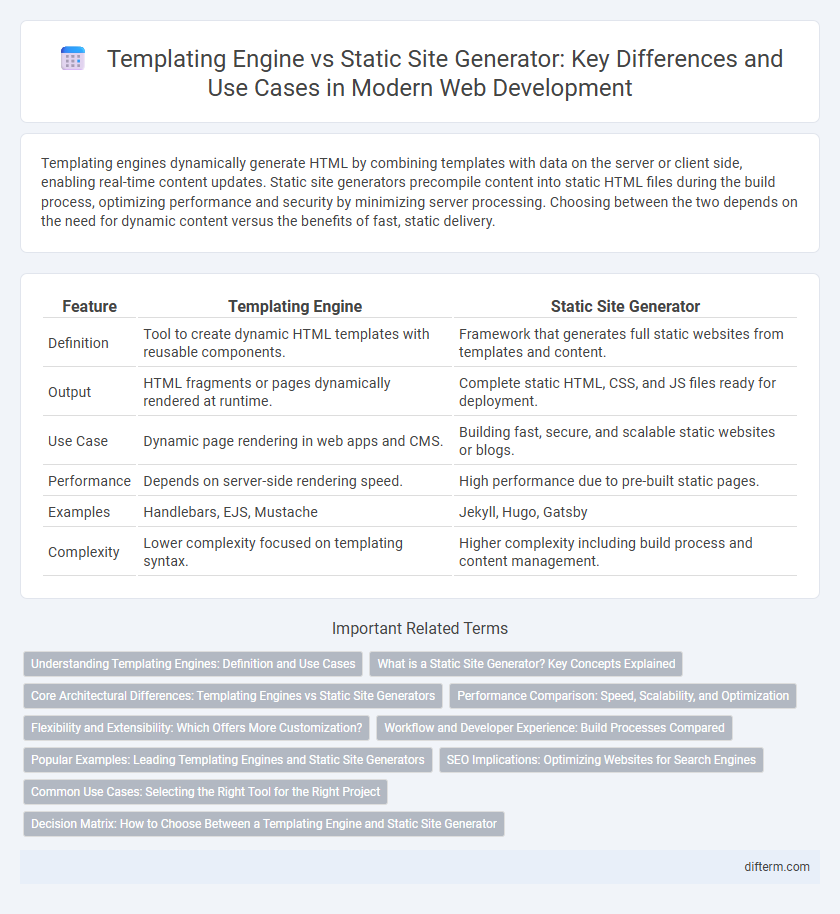Templating engines dynamically generate HTML by combining templates with data on the server or client side, enabling real-time content updates. Static site generators precompile content into static HTML files during the build process, optimizing performance and security by minimizing server processing. Choosing between the two depends on the need for dynamic content versus the benefits of fast, static delivery.
Table of Comparison
| Feature | Templating Engine | Static Site Generator |
|---|---|---|
| Definition | Tool to create dynamic HTML templates with reusable components. | Framework that generates full static websites from templates and content. |
| Output | HTML fragments or pages dynamically rendered at runtime. | Complete static HTML, CSS, and JS files ready for deployment. |
| Use Case | Dynamic page rendering in web apps and CMS. | Building fast, secure, and scalable static websites or blogs. |
| Performance | Depends on server-side rendering speed. | High performance due to pre-built static pages. |
| Examples | Handlebars, EJS, Mustache | Jekyll, Hugo, Gatsby |
| Complexity | Lower complexity focused on templating syntax. | Higher complexity including build process and content management. |
Understanding Templating Engines: Definition and Use Cases
Templating engines are software tools that enable developers to create dynamic HTML content by combining templates with data models, streamlining the rendering process in web applications. They are primarily used to separate presentation logic from business logic, facilitating reusable code and efficient content management in platforms like CMS and web frameworks. Popular templating engines such as Handlebars, Mustache, and EJS support features like conditionals, loops, and partials, enhancing flexibility and scalability in web development projects.
What is a Static Site Generator? Key Concepts Explained
A Static Site Generator (SSG) transforms plain text and templates into static HTML files, enabling fast loading times and improved security by eliminating server-side processing. Key concepts include pre-rendering content during build time, separating data from presentation, and supporting markdown or other content formats for flexible site creation. SSGs like Hugo, Jekyll, and Gatsby facilitate version control integration and streamlined deployment through static hosting services.
Core Architectural Differences: Templating Engines vs Static Site Generators
Templating engines dynamically generate HTML by combining templates with data at runtime, enabling real-time content rendering and flexible UI updates. Static site generators, on the other hand, pre-build entire websites into static HTML files during the build process, optimizing load speed, security, and SEO performance. The core architectural difference lies in the timing of content rendering--templating engines rely on server or client-side rendering at runtime, whereas static site generators produce fully rendered pages ahead of time for deployment.
Performance Comparison: Speed, Scalability, and Optimization
Templating engines render pages dynamically, which can introduce latency under heavy traffic, whereas static site generators pre-build HTML files, resulting in faster load times and superior scalability. Static site generators optimize performance by serving cached content through CDNs, reducing server workload and enabling high concurrency without degradation. Templating engines may require additional optimization such as caching and load balancing to approach the instantaneous delivery and resource efficiency inherent to static site generators.
Flexibility and Extensibility: Which Offers More Customization?
Templating engines provide higher flexibility and extensibility by allowing developers to integrate dynamic content and customize templates with various programming languages and plugins. Static site generators offer streamlined workflows with predefined structures but can be less adaptable when complex, custom features are needed. Choosing between them depends on the desired level of customization and project requirements for dynamic content integration.
Workflow and Developer Experience: Build Processes Compared
Templating engines streamline dynamic content rendering by integrating server-side logic during build time, enabling rapid updates without full rebuilds, which enhances developer productivity in iterative workflows. Static site generators compile entire websites into pre-rendered HTML files in a single build process, offering optimized performance but often requiring longer build times after content changes. Developers benefit from templating engines' flexibility in page rendering, while static site generators provide a more predictable and scalable deployment ideal for content-heavy projects.
Popular Examples: Leading Templating Engines and Static Site Generators
Leading templating engines like Handlebars, Mustache, and EJS excel at dynamic content generation by embedding variables and logic directly within HTML templates. Popular static site generators such as Jekyll, Hugo, and Gatsby enable developers to create performant, SEO-friendly websites by pre-building pages from Markdown files and templates. Both technologies optimize web development workflows, but static site generators emphasize speed and scalability through pre-rendering, while templating engines provide flexible, runtime content rendering.
SEO Implications: Optimizing Websites for Search Engines
Templating engines dynamically generate HTML content, allowing real-time updates but potentially hindering SEO due to slower page rendering and reliance on client-side scripts. Static site generators pre-build HTML files, delivering faster load times and improved crawlability, which enhances search engine rankings by providing fully optimized, indexable content. Implementing static site generators is generally more effective for SEO as they ensure consistent metadata, faster response times, and reduced server dependencies.
Common Use Cases: Selecting the Right Tool for the Right Project
Templating engines are ideal for dynamic web applications requiring real-time content rendering and integration with backend logic, often used in content management systems and e-commerce platforms. Static site generators excel in creating fast, secure, and SEO-friendly websites, perfect for blogs, documentation, and portfolio sites where content changes infrequently. Choosing between the two depends on project requirements like the need for dynamic data handling versus speed and simplicity of static content delivery.
Decision Matrix: How to Choose Between a Templating Engine and Static Site Generator
Choosing between a templating engine and a static site generator depends on project scope, content complexity, and deployment preferences. Templating engines like Handlebars or EJS offer flexibility for dynamic content rendering within applications, ideal for projects needing frequent content updates without full rebuilds. Static site generators such as Gatsby or Hugo excel in performance and security by pre-rendering pages, fitting use cases with primarily static content and faster load times prioritized.
Templating engine vs Static site generator Infographic

 difterm.com
difterm.com